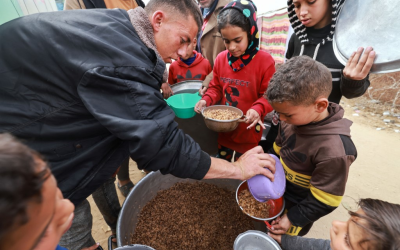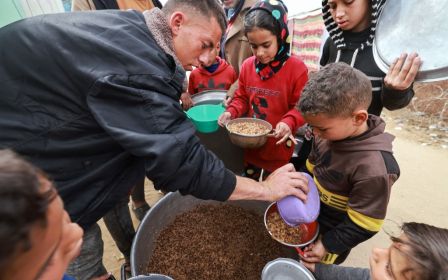War on Gaza: Palestinian child starves to death in Gaza City

An eight-year-old Palestinian girl has died from dehydration and starvation in Gaza City, the NGO, Euro-Med Human Rights Monitor reported on Saturday.
The organisation’s teams in northern Gaza said that Hanin Saleh Hassan Jumaa died from a severe calcium deficiency caused by starvation.
“I [cannot] forget the night of my daughter Hanin’s death when she asked me for food, and I told her, ‘Sleep, I will bring you in the morning,” her father said.
He said that the following morning, she began to moan. “When I sat next to her, I found her as if she was preparing to die.
“I rushed her...to the hospital on a donkey cart due to the lack of cars, only for the doctor to tell me that my daughter had died from dehydration and lack of food."
New MEE newsletter: Jerusalem Dispatch
Sign up to get the latest insights and analysis on Israel-Palestine, alongside Turkey Unpacked and other MEE newsletters
The rights group warned in January of the growing risk of famine especially among children and the elderly. It cited the earlier death of infant Jamal Mahmoud Jamal Al-Kafarna on 18 January, who died "of hunger in his mother's arms".
Euro-Med Monitor also reported the death of one-year-old Baraa al-Haddad from hunger and dehydration on 30 December, and 14-year-old Jana Deeb Qudeih, who had cerebral palsy, on 8 December.
"This tragic incident of a young girl dying from hunger is a stark reminder of the severity of the crisis in Gaza, with hunger at catastrophic levels and children being particularly vulnerable to starvation," Jean-Michel Grand, Executive Director of Action Against Hunger UK told Middle East Eye.
Aid denied to north Gaza
According t0 the World Food Programme (WFP), Palestinians in Gaza now make up 80 percent of people facing starvation worldwide.
A UN report published in December warned that 93 percent of people in the besieged enclave face “crisis levels of hunger,” and that a quarter of the strip’s population faces “catastrophic hunger and starvation".
According to the UN special rapporteur on the right to food, all children under five in Gaza, 335,000, are at high risk of starvation.

WFP spokesperson Steve Taravella said in December: “The scale and swiftness of this crisis is unprecedented in modern times,” adding that “If current predictions continue, we will reach famine by February."
Colonel Elad Goren, who heads Cogat, an Israeli military body that runs the occupied West Bank's civilian and security affairs, rejected the report’s findings, claiming in a press conference in December that, “There is no starvation in Gaza, period."
According to the UN's humanitarian coordination agency OCHA, the situation is particularly dire in Rafah and the north of Gaza, where 15 percent of children are facing acute malnutrition amid aid shortages.
“Save the Children’s staff on the ground have said that there is a severe shortage of food aid reaching them and that they have been unable to find items like flour or to afford it, reporting a bag of flour being sold for up to $140," Randa Ghazy of Save the Children told MEE.
"A staff member in Rafah said that sometimes families only receive one biscuit per person or a can of beans for an entire family. A staff member in Al-Mawasi said that the situation was desperate and that he had met people who had not eaten any food for three days," she added.
OCHA reported that aid convoys are increasingly being denied access to Gaza’s north, with over half of the aid missions refused access in January. This is up from 15 percent in December.
The agency added that Israeli forces "at times required justifications" for fuel destined for health facilities and "imposed reductions on the volume of assistance, such as the quantity of food".
According to the agency, the restrictions on aid leave 300,000 people facing a growing risk of famine. Many are resorting to grinding up animal fodder for sustenance.
Middle East Eye delivers independent and unrivalled coverage and analysis of the Middle East, North Africa and beyond. To learn more about republishing this content and the associated fees, please fill out this form. More about MEE can be found here.




